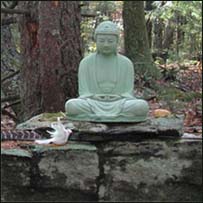|
|
 |
Please support Dharma Seed with a 2025 year-end gift.
Your donations allow us to offer these teachings online to all.

|

|

|
The greatest gift is the
gift of the teachings
|
|

|
| |
|
Dharma Talks
|
2023-04-07
Ursache von dukkha
50:01
|
|
Renate Seifarth
|
|
|
Über die Kräfte von Verlangen, Ablehnung und Unwissenheit. Ihr Auftreten ist natürlich und in gewisser Weise wichtig für unser ÜBerleben. Ohne ein tieferes Verstehen sind sie aber Ursache von Verstrickung und tiefem Leid. Sehen wir die Merkmale aller Dinge mit Einsicht, befreien wir uns von ihrer leidbringenden Kraft.
|
|
Waldhaus am Laacher See
:
Waldhaus Osterkurs
|
|
|
2023-04-06
Worum es sich in der Lehre des Buddha dreht
48:40
|
|
Renate Seifarth
|
|
|
Der Buddha spricht vier große Themen an, auch die vier Wahrheiten genannt. Im ersten Thema geht es darum, dukkha zu erkennen und zu verstehen. Dazu gehört auch zu verstehen, was unter dukkha verstanden wird. Weiter spricht er von einer Ursache des dukkha, die wir überwinden können. Gleichzeitig liegt hier die Ursache für weiteres dukkha. Diesen Kreislauf kann durchbrochen werden. Der Schwerpunkt im Vortrag liegt auf dukkha.
|
|
Waldhaus am Laacher See
:
Waldhaus Osterkurs
|
|
|
2023-04-05
Finding True Refuge in This Living Dying World – Part 1
51:44
|
|
Tara Brach
|
|
|
This week, I began a two-part series inspired by Pema Chödron’s newest offering, How We Live is How We Die. It’s a powerful book that I highly recommend!
One of our deepest inquiries is how to find happiness and peace in an inherently insecure world. In these talks, we’ll explore the ways we habitually try to control our lives, and the practices of presence that allow us to cherish this living world and find freedom in the midst of change and loss.
|
|
Insight Meditation Community of Washington DC
|
|
|
2023-04-05
Entwicklung eines offenen Herzens
38:34
|
|
Renate Seifarth
|
|
|
Der Gegenpol zur Entwicklung von Weisheit liegt in der Entwicklung eines offenen Herzens. Dieses drückt sich aus in einer inneren Haltung liebender Güte, des Mitgefühls und der Mitfreude. Eine solche innere Haltung bzw. innere Absicht kann durch die Mettapraxis kultiviert werden. Die Betonung im Vortrag liegt auf Metta.
|
|
Waldhaus am Laacher See
:
Waldhaus Osterkurs
|
|
|
2023-04-05
Awakening and Habitual Tendencies 2
60:59
|
|
Donald Rothberg
|
|
|
We continue to explore a theme coming out of Donald's recent month-long retreat, of how we can hold and work with the understanding that there is both a process of awakening, often seen as mostly gradual, and a typically everyday experience of our habitual tendencies, including our difficulties and challenges. We review and expand some of what we examined in the previous session, including looking more at how the Buddha understood the nature of samsara and nirvana, and at the seven practices suggested last week for navigating this area (available to be downloaded--see the previous week's talk). We then go somewhat further and deeper, pointing to further ways of practicing, such as inquiring into the sense of self found in different habitual tendencies, and developing a devotional attitude toward both our ordinary lives and our habitual tendencies, as making possible the awakening process. We also touch on Mahayana and Vajrayana perspectives--that samsara and nirvana are not different (articulated by Nagarjuna), and that awakened awareness and habitual tendencies are not different (from Tibetan Dzogchen). These practices and perspectives help us to maintain confidence and faith in awakening in the midst of things!
|
|
Spirit Rock Meditation Center
:
Monday and Wednesday Talks
|
|
|
2023-04-04
Weisheit durch Achtsamkeit
44:33
|
|
Renate Seifarth
|
|
|
Weisheit ist große Klugheit, die auf Lebenserfahrung und Einsicht in die Zusammenhänge ruht. Der bewusste Zugang zu unserer Erfahrung auf allen Ebenen des Körpers und Geistes mittels Achtsamkeit und Sammlung führt zu einer solchen Weisheit. Dies ist das Ziel der Vipassana-Praxis.
|
|
Waldhaus am Laacher See
:
Waldhaus Osterkurs
|
|
|
2023-03-30
Reflective Meditations - Utilizing the Thinking Mind
69:24
|
|
Ajahn Achalo
|
|
|
A talk and Q&A at Wat Marp Jan on the occasion of Ajahn Anan's birthday. Q&A starts: 35:18 Q1 May I know how can one start to train patient endurance? If one does not have any virtue, [does it mean] one cannot practice patient endurance? 39:48 Q2 Virtues mean high moral standards. How can one develop virtues? 43:33 Q3 How can I start to integrate meditation practice in my daily life when I feel I am still a slave to my cravings and often fall into their control and indulge in them? 46:50 Q4 How can I apply metta to myself and others and really mean it, when it comes to practicing in the sangha community. There is a difficult member in the sangha and saying may he or she be well is not working at least in my case it seems. Any advice please? 55:12 Q5 How do we train to rejoice in others' good fortune when we are having a bad time in our life? 57:52 Q6 What is your advice on doubt regarding which tradition to follow? 1:01:39 Q7 You spoke about developing equanimity [towards dukkha]. How can we practice this if the dukkha is overwhelming and we just want to escape the pain? 1:04:36 Q8 If I am unable to control my craving for food, does it mean I do not have virtue? I find myself gobbling down food and then it is never enough. I always tell myself it will be the last time but the cycle repeats tomorrow. 1:07:12 Q9 Could you give more detail about how to make an aspiration for one's next life? [example given]
|
|
Wat Marp Jan
|
|
|
|
|